
Across from Red Sea tobacconist and flanked by a dive bar, parking lot, and storage unit is Urban Adamah, a one and a quarter acre Jewish urban farm in the heart of Berkeley, California. Rows of collard greens, chard, onions, beets, and peas radiate from a newly-built yurt and cob oven. Inside the farm, the surrounding city falls into a distant hush. Young people pushing wheelbarrows occasionally look up to greet wandering strangers.
Urban Adamah is completely open to the public so long as tasty fingers are kept to themselves. Host to a residential fellowship, a Hebrew school for children from the San Francisco Bay Area, and a farmer’s market, the farm donates every vegetable and flower they grow to the community. Founded by Adam Berman in 2010, Urban Adamah originated as a spin-off project from Adamah, a Jewish leadership residential program in Connecticut.
Now they are their own, unique program, mixing organic farming with social justice. They offer sustainability discussions along with their public Jewish holiday feasts and are a part of the growing number of environmentally mindful Jewish farms across the U.S.
I was able to talk to Zach, one of the program’s participants, this week. He told me most of the eleven to fourteen fellows that work at the farm are not San Francisco Bay Area natives. The majority are twenty-somethings with roots scattered across the country who felt disillusioned with Judaism after college. Now, they all live together in an “ugly cement” house with big kitchen a couple of blocks away while working full time at Urban Adamah.
For fellows like Zach, Urban Adamah has given them a fresh approach to Judaism that centers on gratitude. Gratitude for all living things and an awareness of the transformative process of nature we are all a part of.
“Like the laws of Kashrut, what is it really saying?” he explained to me. “Pay attention to what goes into your body. Be aware of your food source.” I notice that the entire farm is sprinkled with these “back to basics” biblical references.
Zach leaves to continue farming and I go up to a sign that reads: Bal Tashchit, translated as “do not destroy” from Deuteronomy. The principle prohibits us from cutting down fruit trees in times of war, even if it were to help us defeat our enemies. This law was later expanded to include avoiding all types of waste.
I walk through a row of vegetables planted in pallet beds—Urban Adamah’s answer to gophers and polluted city soil. The pallets are made from recycled materials including reused coffee sacks and bits of grade plastic. Passing a pit full of honey comb with dangling, buzzing bees I read another sign: Mechayei Hameitim, translated as “blessed are you, spirit of the world, for enlivening the dead.” Here the blessing is linked with awareness of life and death. The rejuvenating cycle of dying matter that sustains new life is represented in many ways, simple composting included.
Suddenly, I remembered a paper I wrote in a class about the story of Cain and Abel. It always bothered me that God rejected Cain’s food offering from the soil for Abel’s lamb. I couldn’t understand it. In the end, I figured that God thought the proper gift was a sacrifice, a life.
Though my hippie education had taught me that plants were just as much alive as animals, I understood the biblical distinctions that are made for the soul. I knew that the ground was cursed at the end of Genesis, with soil symbolizing death and blood. The name Adam comes from the word for soil, adamah, which contains the root word dam, meaning blood.
Originally a life-giving substance, soil also functions as human grave-sites. When Abel offers the first of his flock to God he gives a blood-filled creation. Blood is the “seed of life” in the Torah and Abel is literally offering a life to God. When Cain presents his crops, he is offering a blood-less thing. Abel represents the nomad who lives in communion with the land. Cain on the other hand, is a cultivator, a manipulator who uses tools and later represents the father of civilization. I was not convinced that God liked farmers at all.
Needless to say, generations later Jewish farming looks a little different.
Over the past couple decades, Jewish communities have embraced environmentalism. There is a lot of ecological wisdom in the Torah and young people are excited to read the text with new green-tinted glasses. Environmentalism also champions communal thinking, something Jews have been valuing for thousands of years. Urban Adamah is of course not the only organic farm that synthesizes sustainability practices with Jewish education.
Similar projects include The Gan Project in Chicago which teaches ways to incorporate environmental education into modern Jewish life, Philadelphia’s Jewish Farm School that trains participants about food systems and sustainable agriculture, Hazon a large group that sponsors organic health programs, environmental stewardship, along with Jewish education, are just a few.
Walking through rows of golden Calendula in pallets raised off the ground I notice a trail of fluttering Buddhist prayer flags in the wind. I feel at peace. Urban Adamah has successfully created a sacred space, one of solace and accountability, where rampant individualism is left at the door for communal thinking. I spot a sign that reads “Goats around the corner.”
Following the arrow, I stumble upon a big pen of three chestnut goats that all run up to me excitedly. I break into a smile, pet them, and back away, back into the garden, back into the right-angled cement gridlock of the city streets.

